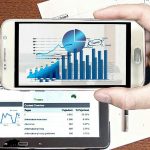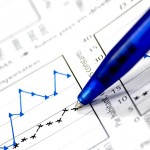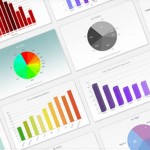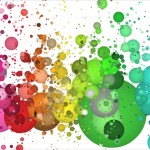Linking Big Data Visualization to the Value of KPIs

Given that we live in a time of data and information overload, we really need to have better mechanisms to make sense of it all. Data visualization supports the transfer of information to knowledge by illustrating hidden issues and opportunities in big data sets.
Big data is creating unrivaled opportunities for businesses, aiding them to achieve faster and deeper insights that can strengthen the decision making process, improve customer experience, accelerate the speed of innovation and gain a competitive advantage.
A significant amount of the human brain is dedicated to visual processing, resulting in our sight having a sharpness of perception far surpassing our other senses. Effective data visualization shifts the balance between perception and cognition. The visual cortex is used at a higher capacity and the viewer understands the presented information much quicker, better and is able to make a superior decision based on the findings.
Businesses are increasingly turning to data visualization to discover the overwhelming amount and variety of data cascading into their operations, and to eliminate the struggle of just storing the data and focus on how to analyze, interpret and present it in a meaningful way. The trend towards data visualization is worth delving into by any business seeking to derive more value from big data.
The IBM framework for tackling big data focuses on “the four “V’s” (volume, velocity, variety and veracity), but does not emphasize enough another “V” that requires attention, namely visualization. Even with the use of business intelligence tools and the incredible exponential increase in computer power, the need to consume information in a meaningful manner exceeds the ability to process it.
Visualization plays a key role starting from the raw input of the big data, where structures and underlying patterns that may be held within the data can be observed or formed, to the end result of a visual representation that presents valuable key insights in a fast, efficient and clever manner.
Crafting a visualization is more than simply translating a table of data in a visual display. Data visualization ought to communicate information in the most effective way, with the prime purpose of truly revealing data in a quick, accurate, powerful and long-lasting manner.
The main problem with big data involves complexity. Information and data is growing exponentially with time, as an increasing amount of data is made available on the internet. Furthermore, the number of insights, opportunities or hypotheses hidden in a dataset is exponential to the size of the datasets.

In achieving efficiency and ensuring the comprehensibility of visual representation resulted from big data, KPIs can be used, as to attain the goal of graphical excellence and to add value to the end result. Big data visualization requires skills that are not intuitive and the entire process relies on principles that must be learned. Each big data visualization created should follow a clear path to success, namely: attain, define, structure, extract, load, display, refine the data and interact with it.
Key performance indicators add value to the entire process by ensuring clarity in developing the strategy of the project, focus on what matters and requires attention, as well as improvement by monitoring the progress towards the desired state.
When developing a project of big data visualization, the process should follow a cursive and pre-defined flow in accordance with the project needs and the requirements of the end-user. These recommended stages are:
1.Acquiring the data: this is usually how the process starts, unrelated with the platform which provides the data. In the process of big data collection, there is also the issue of data selection. Instead of “just throwing it all in”, one should focus on selecting high quality data, which is relevant to the project’s objective and does not add noise to the end result.
The noisier the data is, the more problematic it will be to see the important trends. It is suggested to have a clear strategy for the data sources required, as well as for the subsets of data relevant to the questions the project wants to answer to.
2.The next phase in the process refers to structuring of the acquired data. This includes the process of organizing the data to align it to one standard. The data store might be comprised of a combination of structured, semi-structured and unstructured data.
At this stage, it is easier to identify the common aspects in each sets of data and to find relationships between the data at hand. This includes translating system specific data coding to meaningful and usable data (the platform where the data will be aggregated does not know that the set of data labeled “Customer No.” is the same as “# Customer” or “ID-Customer”).
3.After cleaning the data, filtering through enormous amounts of data and replicating the application logic to make the data self-describing, the process continues with loading the data in the preferred platform and choosing the visual mode of representation.
In this stage, it can be noted if the background data is very noisy or high quality, as the emerging visual representation will be either hard to read or irrelevant to the strategic objective of the project, or clear and visually engaging.
By implementing key performance indicators along the project and linking them to the project objectives, the increased value will be added in the form of:
- Better quality of the visual representations;
- Fewer project delays;
- Less rework along the way;
- Improved productivity;
- Greater contribution to the visuals’ value;
- Enhanced growth and innovation of the visual representation;
- Easier project assessment.
Image Source:

Tags: Data Visualization, KPI, operational performance






Houda Hedi Baccouche
| #
Data visualization supports the transfer of information to knowledge by illustrating hidden issues and opportunities in big data sets. Businesses are increasingly turning to data visualization to discover the overwhelming amount and variety of data cascading into their operations, and to eliminate the struggle of just storing the data and focus on how to analyze, interpret and present it in a meaningful way. The main problem with big data involves complexity.
When developing a project of big data visualization, the process should follow 3 recommended stages: selecting high quality data relevant to the project’s objective, structuring of the acquired data, loading the data in the preferred platform and choosing the visual mode of representation.
Reply
Mohammad Jarrash
| #
Data visualization supports the transfer of information to knowledge by illustrating hidden issues and opportunities in big data sets.
In achieving efficiency and ensuring the comprehensibility of visual representation resulted from big data, KPIs can be used, as to attain the goal of graphical excellence and to add value to the end result
Reply
munirah almalki
| #
Data visualization supports the transfer of information to knowledge by illustrating hidden issues and opportunities in big data sets.
1.Acquiring the data: this is usually how the process starts, unrelated with the platform which provides the data.
2.The next phase in the process refers to structuring of the acquired data.
3.After cleaning the data, filtering through enormous amounts of data and replicating the application logic to make the data self-describing, the process continues with loading the data in the preferred platform and choosing the visual mode of representation.
Reply
Fahad Bin Shuayl
| #
Data visualization supports the transfer of information to knowledge by illustrating hidden issues and opportunities in big data sets.
– Acquiring the data: this is usually how the process starts, unrelated with the platform which provides the data. In the process of big data collection, there is also the issue of data selection
– Structuring of the acquired data. This includes the process of organizing the data to align it to one standard. The data store might be comprised of a combination of structured, semi-structured and unstructured data.
– After cleaning the data, filtering through enormous amounts of data and replicating the application logic to make the data self-describing, the process continues with loading the data in the preferred platform and choosing the visual mode of representation.
Reply
Khalid Nour
| #
The author is emphasizing the need of the data visualization to handling big data to achieve faster and deeper insights that can strengthen the decision making process, improve customer experience, accelerate the speed of innovation and gain a competitive advantage. Then he explained how the human brain is dedicated to visual processing as we also heard that visual aid is helpful in our presentations. In sum, Effective data visualization shifts the balance between perception and cognition. The visual cortex of the brain, which is that part of the cerebral cortex that processes visual information is located in the occipital lobe. It is used at a higher capacity and the viewer understands the presented information much quicker, better and is able to make a superior decision based on the findings.
Then the author is adding visualization to the four V’s (volume, velocity, variety and veracity) of IBM framework for tackling big data but the main problem for it is complexity. To solve this problem we need to understand the KPIs add value to big data visualization through focus, clarity and improvement. The recommended stages to develop any project with big data visualization is the following:
1) Acquiring the data
2) Structuring the acquired data
3) Loading the data in the preferred platform
4) Choosing the visual mode of representation
Reply
Iris Daisy De Jesus
| #
When setting up your data visualization try not to make is to heavy. We are visual beings and the heavier the visualization the harder it is to focus. When tracking big data remember the 4 or lets say the 5 V;s, volume, velocity, variety, veracity and visualization. Data visualization should communicate information in the most effective way possible. The target is to present the data in a quick, accurate, powerful and long-lasting manner. 1st t step is the acquire the data, 2nd structure the data then 3rd the process continues with loading the data in the preferred platform and 4th choosing the visual mode of representation.
Reply
Drissa TRAORE
| #
Cet article nous parle de comment lier la visualisation du Big Data à la valeur des KPI
La visualisation des données prend en charge le transfert d’informations vers les connaissances en illustrant les problèmes cachés et les opportunités dans les grands ensembles de données. La visualisation des données doit communiquer les informations de la manière la plus efficace, dans le but premier de vraiment révéler les données d’une manière rapide, précise, puissante et durable.
Chaque visualisation Big Data créée doit suivre un chemin clair vers le succès, à savoir: atteindre, définir, structurer, extraire, charger, afficher, affiner les données et interagir avec elles. Lors du développement d’un projet de visualisation Big Data, le processus doit suivre un flux cursif et prédéfini en fonction des besoins du projet et des exigences de l’utilisateur final. Ces étapes recommandées sont:
1. Acquérir les données
2. La phase suivante du processus concerne la structuration des données acquises.
3. Après avoir nettoyé les données, filtré d’énormes quantités de données et répliqué la logique de l’application pour rendre les données auto-descriptives, le processus se poursuit avec le chargement des données dans la plate – forme préférée et le choix du mode de représentation visuelle
En mettant en œuvre des indicateurs de performance clés tout au long du projet et en les reliant aux objectifs du projet, la valeur accrue sera ajoutée sous la forme de:
• Meilleure qualité des représentations visuelles;
• Moins de retards de projet;
• Moins de retouches en cours de route;
• Amélioration de la productivité;
• Une plus grande contribution à la valeur des visuels;
• Augmentation de la croissance et de l’innovation de la représentation visuelle;
• Évaluation de projet plus facile.
Reply
Jorge Roman Torres
| #
La visualización de datos apoya la transferencia de información al conocimiento al ilustrar problemas y oportunidades ocultos en grandes conjuntos de datos. La visualización de datos eficaz cambia el equilibrio entre la percepción y la cognición. Las empresas recurren cada vez más a la visualización de datos con el fin de obtener más valor de los macrodatos. La visualización de datos debe comunicar la información de la manera más eficaz, con el objetivo principal de revelar datos realmente de una manera rápida, precisa, poderosa y duradera. Para lograr la eficiencia y garantizar la comprensibilidad de la representación visual resultante de los macrodatos, se pueden utilizar KPI para lograr el objetivo de la excelencia gráfica y agregar valor al resultado final. Los indicadores clave de desempeño agregan valor a todo el proceso al asegurar la claridad en el desarrollo de la estrategia del proyecto, se enfocan en lo que importa y requiere atención, así como la mejora al monitorear el progreso hacia el estado deseado. Las etapas recomendadas para desarrollar cualquier proyecto con visualización de grandes datos son las siguientes:
1. Adquirir los datos:
2. Estructuración de los datos adquiridos.
3. Limpiar los datos.
Reply
reham alaslani
| #
Data visualization supports the transfer of information to knowledge by illustrating hidden issues and opportunities in big data sets.
1.Acquiring the data
2. structuring of the acquired data.
3.After cleaning the data, filtering through enormous amounts of data and replicating the application logic to make the data self-describing, the process continues with loading the data in the preferred platform and choosing the visual mode of representation
Reply
Samir MohamedAbdelghafar
| #
Oh really Big data is creating unrivaled opportunities for businesses, aiding them to achieve faster and deeper insights that can strengthen the decision making process, improve customer experience, accelerate the speed of innovation and gain a competitive advantage.
The main problem with big data involves complexity. Information and data is growing exponentially with time, as an increasing amount of data is made available on the internet. Furthermore, the number of insights, opportunities or hypotheses hidden in a dataset is exponential to the size of the datasets.
and achieving efficiency and ensuring the comprehensibility of visual representation resulted from big data, KPIs can be used, as to attain the goal of graphical excellence and to add value to the end result.
These recommended stages are:
1.Acquiring the data
2. structuring of the acquired data.
3.After cleaning the data, filtering through enormous amounts of data and replicating the application logic to make the data self-describing, the process continues with loading the data in the preferred platform and choosing the visual mode of representation
Reply
Amel AGGUINI
| #
Big data’s ability to transform KPIs for the better isn’t about collecting impressive amounts of data or slicing and dicing that data in lots of different ways. Rather, the power of big data lies in how can be use it; and, in the case of KPIs and performance management, that means gathering the insights that will help people in the company make better decisions and improve performance.
Reply
Raoum
| #
By implementing key performance indicators along the project and linking them to the project objectives, the increased value will be added in the form of:
•Better quality of the visual representations;
•Fewer project delays;
•Less rework along the way;
•Improved productivity;
•Greater contribution to the visuals’ value;
•Enhanced growth and innovation of the visual representation;
•Easier project assessment.
Reply
Ghaida
| #
The increased value will be added in the form of:
Better quality of the visual representations;
Fewer project delays;
Less rework along the way;
Improved productivity;
Greater contribution to the visuals’ value;
Enhanced growth and innovation of the visual representation;
Easier project assessment.
Reply
Nada Alomair
| #
No matter what business or career you’ve chosen, data visualization can help by delivering data in the most efficient way possible. As one of the essential steps in the business intelligence process, data visualization takes the raw data, models it, and delivers the data so that conclusions can be reached. In advanced analytics, data scientists are creating machine learning algorithms to better compile essential data into visualizations that are easier to understand and interpret.
Specifically, data visualization uses visual data to communicate information in a manner that is universal, fast, and effective. This practice can help companies identify which areas need to be improved, which factors affect customer satisfaction and dissatisfaction, and what to do with specific KPI (where is we from the goal and how should we act). Visualized data gives stakeholders, business owners, and decision-makers a better prediction of performance.
Reply
Performance Magazine Big Data: The Next Frontier of Performance Management
| #
[…] should recognize that integrating Big Data into performance management would allow them to further improve their performance , make strategic […]
Reply
Hadeel
| #
Data visualization supports the transfer of information to knowledge by illustrating hidden issues and opportunities in big data sets.
The recommended stages to develop any project with big data visualization is the following:
1) Acquiring the data
2) Structuring the acquired data
3) After cleaning the data, filtering through enormous amounts of data and replicating the application logic to make the data self-describing, the process continues with loading the data in the preferred platform and choosing the visual mode of representation
Reply
Hanouf
| #
, the Data visualization is important because it supports the transfer of information to knowledge by illustrating hidden issues and opportunities in big data sets.
Moreover, implementing the KPIs along the project and linking them to the project objectives, the increased value will be added in the form of: better quality of the visual representations, fewer project delays, less rework along the way, improved productivity, greater contribution to the visuals’ value, enhanced growth and innovation of the visual representation, and easier project assessment.
Reply
best university Egypt
| #
best university Egypt
[…]we came across a cool internet site that you simply could possibly take pleasure in. Take a search should you want[…]
Reply
FiverrEarn
| #
FiverrEarn
[…]that may be the finish of this article. Here you will uncover some internet sites that we consider you will value, just click the hyperlinks over[…]
Reply
norah binbaz
| #
i will elaborate on the following Noisy data
Noisy data can make it challenging to identify important trends and patterns. Therefore, having a clear strategy for selecting data sources and identifying relevant subsets of data is crucial. This involves understanding the specific questions the project aims to answer and ensuring that the selected data is appropriate for addressing those questions.
By carefully selecting high-quality data and avoiding noise, the subsequent stages of data visualization, such as structuring, cleaning, and visualizing, become more effective. This leads to more accurate and insightful visual representations that support better decision-making and analysis.
Reply